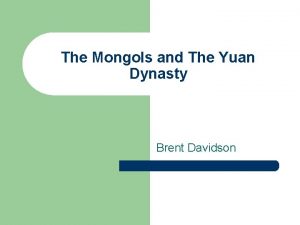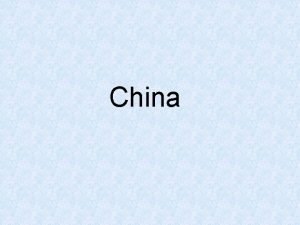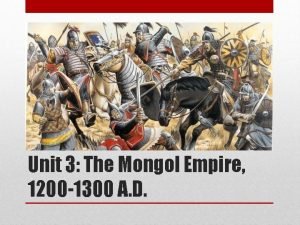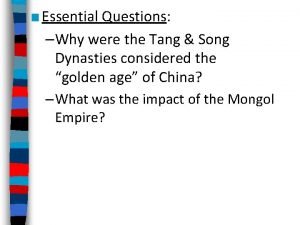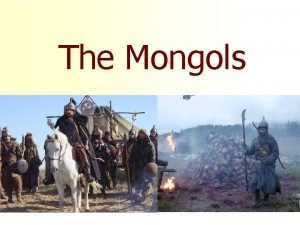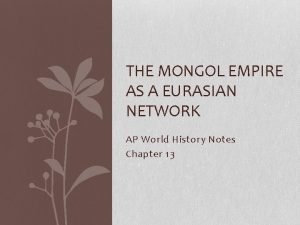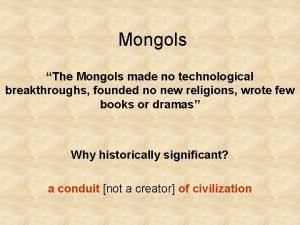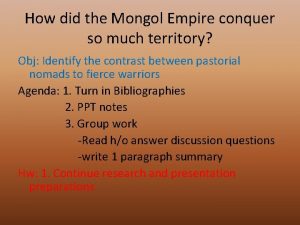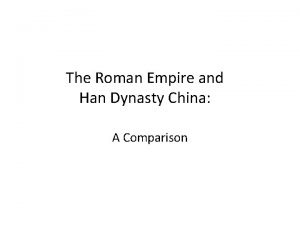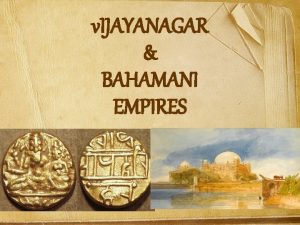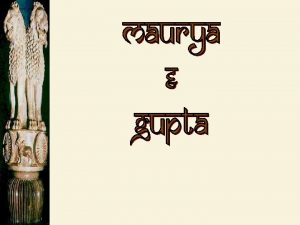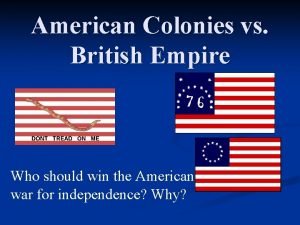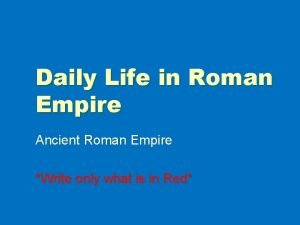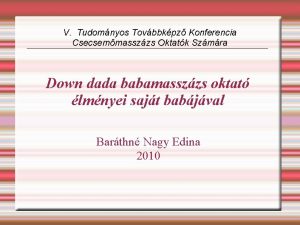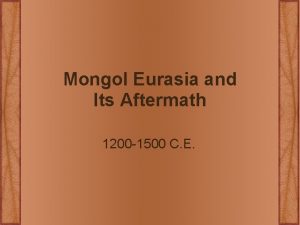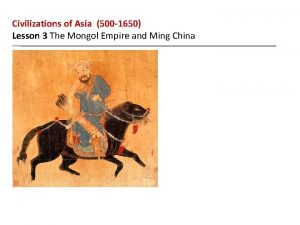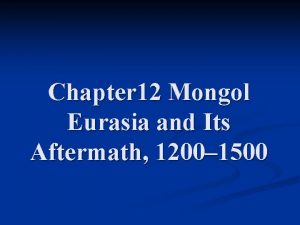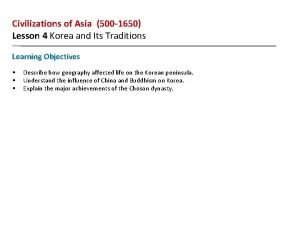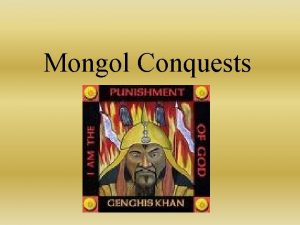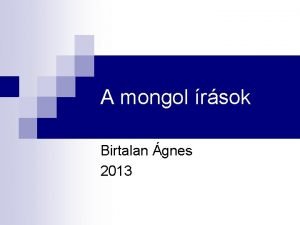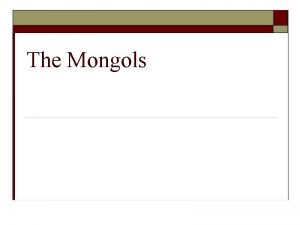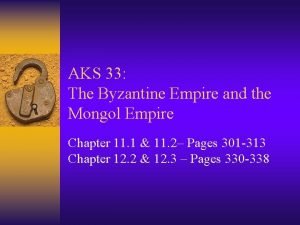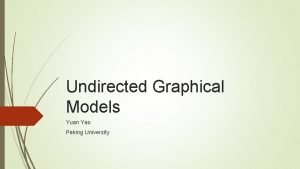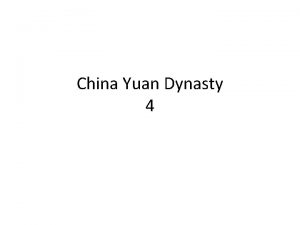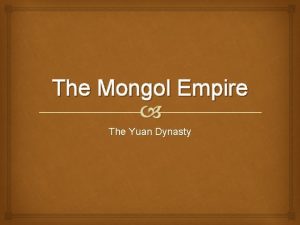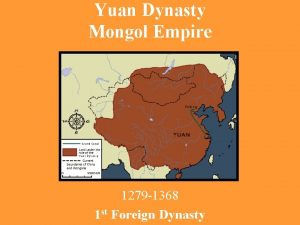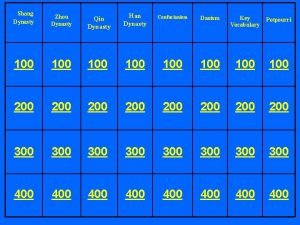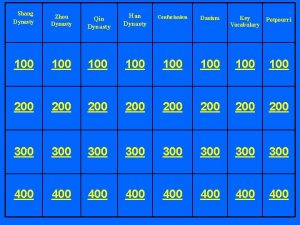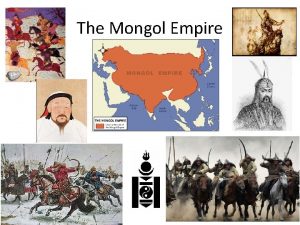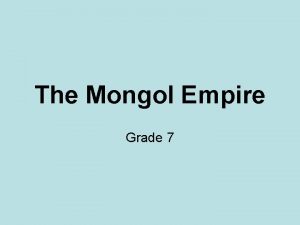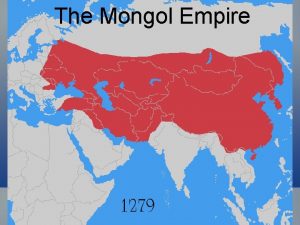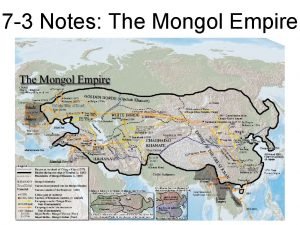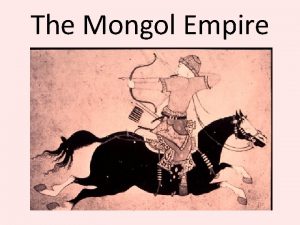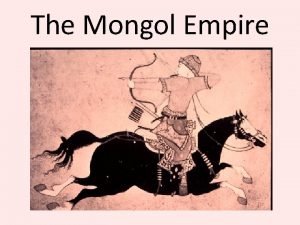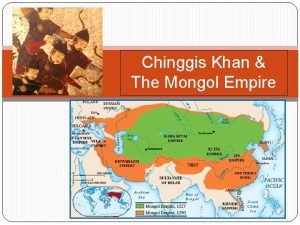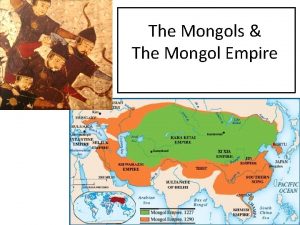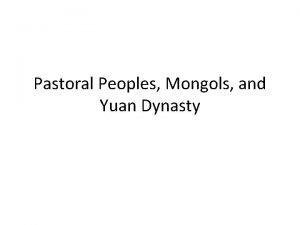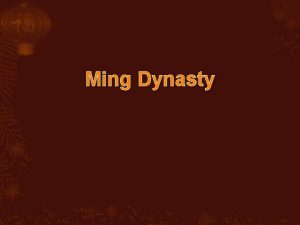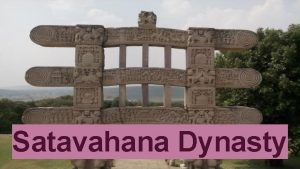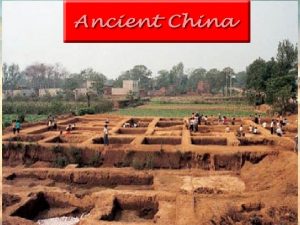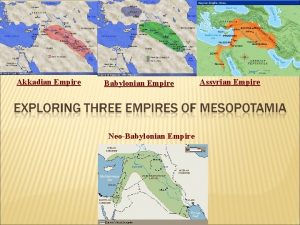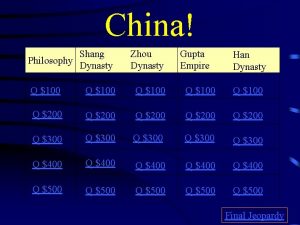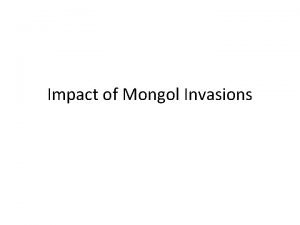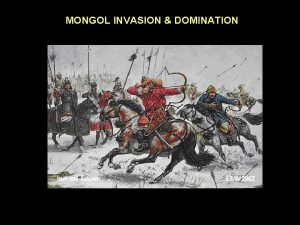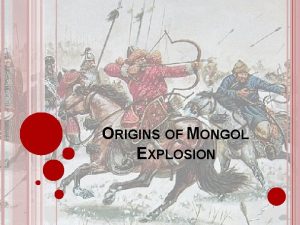Yuan Dynasty and Mongol Empire The Extent of




![Xinjiang Region – Typical Uygher [Mongol] “Yurt” Xinjiang Region – Typical Uygher [Mongol] “Yurt”](https://slidetodoc.com/presentation_image_h2/3fdca8834580992e34eb2e68c8090391/image-5.jpg)






![Mongol Rule-under Chingghis z Temujin --> Genghis Khan [“Universal Ruler”] – 1162 – 1227 Mongol Rule-under Chingghis z Temujin --> Genghis Khan [“Universal Ruler”] – 1162 – 1227](https://slidetodoc.com/presentation_image_h2/3fdca8834580992e34eb2e68c8090391/image-12.jpg)
![The MONGOLS [“Golden Horde”] z Genghis Khan’s Tax Laws: – If you do not The MONGOLS [“Golden Horde”] z Genghis Khan’s Tax Laws: – If you do not](https://slidetodoc.com/presentation_image_h2/3fdca8834580992e34eb2e68c8090391/image-13.jpg)










![Yuan (Mongol) Dynasty, 12791368 C. E. z Kublai Khan [r. 1260 -1294] – Pax Yuan (Mongol) Dynasty, 12791368 C. E. z Kublai Khan [r. 1260 -1294] – Pax](https://slidetodoc.com/presentation_image_h2/3fdca8834580992e34eb2e68c8090391/image-24.jpg)





- Slides: 29

Yuan Dynasty and Mongol Empire

The Extent of the Mongol Empire The Mongols built a vast empire across much of Asia, founded the Yuan dynasty in China, and opened China and the region to greater foreign contacts and trade.

The Mongols In the 1200 s a nomadic people called the Mongols burst forth from Central Asia to create the largest land empire in history. Nomads from the Steppe Fierce Warriors • Vast steppes, grasslands, stretch across north-central Eurasia, home to nomadic peoples • Like Huns, Turks, the Mongols emerged as powerful nomadic people on Central Asian steppes • Steppes too dry for farming • Herded sheep, goats • Nomads relied on herds of domesticated animals • Skilled with horses • Often traded; but also swept down on settlements, took what they wanted • Accustomed to living in harsh environment, competing for scarce resources • Tough people, fierce warriors

Mongolian Steppes
![Xinjiang Region Typical Uygher Mongol Yurt Xinjiang Region – Typical Uygher [Mongol] “Yurt”](https://slidetodoc.com/presentation_image_h2/3fdca8834580992e34eb2e68c8090391/image-5.jpg)
Xinjiang Region – Typical Uygher [Mongol] “Yurt”

The Universal Ruler Separate Clans • Mongols divided into separate clans, each led by a khan, chief • Khans rose to power through military skills, ability to lead • 1100 s, Temujin, powerful khan, began to conquer rivals, unite Mongol clans Genghis Khan • 1206, Temujin completed task, took name Genghis Khan, “Universal Ruler” • Set out to build empire, organized Mongols into powerful military machine • Strict discipline, demanded loyalty, rewarded those who pleased him Campaign of Conquest • Mongol forces began bloody campaign of conquest; highly mobile armies • Employed brutality, psychological warfare; burned towns, killed inhabitants • Sent agents ahead to instill fear; soon people surrendered without a fight

Mongol Invasions

Mongol Warriors

Mongol Archer

Mongol Warriors

The Mongol Empire • Genghis Kahn led Mongols in conquering much of Asia • Mongols learned art of siege warfare, gunpowder in fights against Chinese, Turks • At Genghis Kahn’s death, 1227, Mongols controlled much of northern China, Central Asia • Sons, grandsons took up challenge of world conquest Khanates • Genghis Kahn’s empire divided into four khanates, heir ruled each region; new Great Khan ruled over whole empire • Grandsons resumed efforts to complete conquests of China, Korea, Persia • 1236, Golden Horde, or Tartars, began conquering Russia, Poland, Hungary
![Mongol Ruleunder Chingghis z Temujin Genghis Khan Universal Ruler 1162 1227 Mongol Rule-under Chingghis z Temujin --> Genghis Khan [“Universal Ruler”] – 1162 – 1227](https://slidetodoc.com/presentation_image_h2/3fdca8834580992e34eb2e68c8090391/image-12.jpg)
Mongol Rule-under Chingghis z Temujin --> Genghis Khan [“Universal Ruler”] – 1162 – 1227 Consulted with Confucian scholars on how to rule China, design weapons, improve trade with further lands to the east and the west. – Secure trade routes prosperous merchants and wealthy cities – All religions were tolerated
![The MONGOLS Golden Horde z Genghis Khans Tax Laws If you do not The MONGOLS [“Golden Horde”] z Genghis Khan’s Tax Laws: – If you do not](https://slidetodoc.com/presentation_image_h2/3fdca8834580992e34eb2e68c8090391/image-13.jpg)
The MONGOLS [“Golden Horde”] z Genghis Khan’s Tax Laws: – If you do not pay homage, we will take your prosperity. – If you do not have prosperity, we will take your children. – If you do not have children, we will take your wife. – If you do not have a wife, we will take your head. z Used cruelty as a weapon some areas never recovered from Mongol destruction!

Gold Saddle Arch – Mongols, 13 c

Gold Saddle, Front View – Mongols, 13 c

The Mongol Peace • Mongols built empire with brutality, ruled peacefully • Tolerated local beliefs, ways of life, allowed local rulers to stay in power as long as they paid tribute to Mongols • Some Mongols adopted aspects of more civilized cultures; Mongols in Central Asia, Persia, adopted Islam Stability in Asia • Mongol Empire established peace, stability across Asia • Some historians call period Pax Mongolica, “Mongol Peace” • Guarded trade routes across Asia, allowed trade to increase; people, goods, ideas flowed across Asia • Some believe Black Plague spread from Asia to Europe during period

Mongol Nobleman, Short bow,

Robe of a Mongol Nobleman, early 14 c

Yuan Golden Bowl, 13 c

Yuan Porcelains & Ceramics

How were the Mongols able to build a vast empire across much of Eurasia? Answer(s): army was skilled and well organized, rules promoted loyalty and obedience; tactics involved brutality and psychological warfare; built fear in those they conquered

The Yuan Dynasty Great Kahn • 1260, Kublai Khan became Great Kahn of Mongol Empire • Determined to complete conquest of China begun in 1235 Kublai Kahn Rules China Southern Song • Mongols ruled northern China • Southern Song dynasty ruled in south, fiercely resisted Mongols • 1279, Song defeated; Kublai Khan created Yuan dynasty New Capital • As emperor, Kublai Khan tried to gain loyalty of Chinese subjects • Kublai Khan moved capital to near what is now Beijing • Adopted Chinese practices, gave dynasty Chinese name • Built Chinese-style walled city, lavish palace, adopted Chinese court ceremonies

![Yuan Mongol Dynasty 12791368 C E z Kublai Khan r 1260 1294 Pax Yuan (Mongol) Dynasty, 12791368 C. E. z Kublai Khan [r. 1260 -1294] – Pax](https://slidetodoc.com/presentation_image_h2/3fdca8834580992e34eb2e68c8090391/image-24.jpg)
Yuan (Mongol) Dynasty, 12791368 C. E. z Kublai Khan [r. 1260 -1294] – Pax Mongolica [“Mongol Peace”] • Tolerated Chinese culture but lived apart from them. • No Chinese in top govt. posts. • Believed foreigner were more trustworthy. • Encouraged foreign trade & foreign merchants to live and work in China. ü Marco Polo


Kublai Khan Rules China Mongol Identity • Kublai Khan tried to rule as Chinese emperor • But took care to see Mongols not absorbed into Chinese culture • Mongols lived apart from Chinese, had little in common Separation • Individual friendships between Mongols, Chinese discouraged • Mongols forbidden to marry Chinese • Different laws, taxes for Chinese; could not own weapons, serve in military Limited Power • Kublai Khan distrusted Chinese, limited power • Chinese officials served at local level, could not hold high government posts • Mongols invited foreigners to hold government office

End of the Yuan Dynasty The Yuan dynasty weakened during the last part of Kublai Khan’s reign. One cause was a number of military defeats. All of his invasions into Southeast Asia failed, and Mongol armies suffered huge losses. Japan Attacks • Kublai Khan had set sights on conquering Japan • First attempt: 900 ships attacked Japan, storm destroyed fleet • Tried to invade Japan twice • Second attempt: Khan sent larger fleet, severe storm again wiped out fleet • Disastrous results each time Kamikaze • After two fleets destroyed by storms, Mongols never attempted Japanese invasion • Japanese called storms that saved them kamikaze, “divine wind”

Military and Monetary Losses Weaknesses • Huge military losses in Japan weakened Mongol forces that controlled, protected China • Large amounts spent on public-works projects weakened economy • Weaknesses, Chinese resentment of Mongols, left empire ripe for rebellion • Black Plague was spread by Mongols in the mid 1300 s End of Dynasty • 1294, Kublai Khan died, power struggles erupted. He became more concerned with accumulation of wealth than the efficient administration. • Khan’s successors lacked talent for leadership • Floods, rising taxes further increased discontent • 1300 s, Chinese rebelled, defeated Mongols • Mongols fled to Manchuria, ending foreign rule in China by 1368

Identify Cause and Effect What factors led to the end of the Yuan dynasty? Answer(s): military defeats and failed invasions; lack of good leadership; power struggles; Chinese discontent
 Yuan dynasty map
Yuan dynasty map Manchurian border
Manchurian border What did the mongols do for the silk road
What did the mongols do for the silk road Empire mongol apogée
Empire mongol apogée The difference between empire and kingdom
The difference between empire and kingdom The mongol empire spans eurasia worksheet answer key
The mongol empire spans eurasia worksheet answer key The mongol empire as a eurasian network
The mongol empire as a eurasian network Mongol empire memes
Mongol empire memes The mongol empire spans eurasia answer key
The mongol empire spans eurasia answer key Battle of talas river
Battle of talas river Difference between empire and dynasty
Difference between empire and dynasty Han and roman empire
Han and roman empire Hakka bukka caste
Hakka bukka caste Mauryan empire and gupta empire venn diagram
Mauryan empire and gupta empire venn diagram American empire vs british empire
American empire vs british empire Byzantine empire vs roman empire venn diagram
Byzantine empire vs roman empire venn diagram Mongol redő
Mongol redő Mongol redő
Mongol redő Okaik
Okaik Vikings and turks
Vikings and turks Mongol hierarchy
Mongol hierarchy How did kublai khan organize mongol rule in china
How did kublai khan organize mongol rule in china Mongol hierarchy
Mongol hierarchy How did kublai khan organize mongol rule in china
How did kublai khan organize mongol rule in china Nomadic peoples who herded domesticated animals
Nomadic peoples who herded domesticated animals Mongol írás
Mongol írás What was the impact of russia’s “mongol years”?
What was the impact of russia’s “mongol years”? What was the impact of russia’s “mongol years”?
What was the impact of russia’s “mongol years”? Yuan-pern lee
Yuan-pern lee Model yuan yao
Model yuan yao
